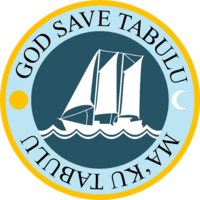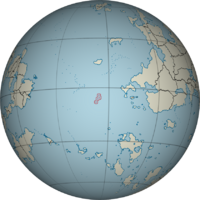Tabuluan Language: Difference between revisions
No edit summary |
No edit summary |
||
| Line 13: | Line 13: | ||
| speakers2 = 56,300 (Second Language) | | speakers2 = 56,300 (Second Language) | ||
| familycolor = Austronesian | | familycolor = Austronesian | ||
| fam1 = [[ | | fam1 = [[Thuadia|Thuado-]][[Caleren|Caleri]] | ||
| fam2 = [[North Caleri Language|North Caleri]] | | fam2 = [[North Caleri Language|North Caleri]] | ||
| fam3 = [[Kristalotovode Language|Kristalotovode]] | | fam3 = [[Kristalotovode Language|Kristalotovode]] | ||
Revision as of 04:18, 24 March 2021
| Tabuluan | |
|---|---|
| Tabulian | |
| Ko'Tabulu | |
 National Seal of Tabulu, depicting the phrase "God Save Tabulu" in both English and Tabuluan. | |
| Pronunciation | /kaːtæbuːluː/ |
| Native to | Tabulu |
| Region | Kristalotovode |
| Ethnicity | Tabuluan |
Native speakers | 149,000 (2014) 56,300 (Second Language) |
Early forms | |
| Dialects | |
| Common Alphabet | |
| Official status | |
Official language in | |
Recognised minority language in | |
| Language codes | |
| ISO 639-1 | tb |
| ISO 639-2 | tbu |
| ISO 639-3 | tbn – inclusive codeIndividual codes: htu – High Tabuluanltu – Low Tabuluanttc – Torvonese-Tabuluan Creolectc – Common-Tabuluan Creole |
| Glottolog | tabu1099[1] |
 Map displaying Tabulu in red, indicating the only areas where Tabuluan is spoken by more than 5% of the population. | |
Tabuluan, known as Ko'Tabulu by its native speakers, and Tabjulina to Tabuluans who speak Torvonese, is a language that originated on the Tabulu Islands and has been spoken by Natives for roughly 650 years. The language's name stems from Tabulu's name, literally "islands of the sweetened ground," and thus Tabuluan means "language of the islands of the sweetened ground." Tabuluan has very little relation to most other languages, even regional ones, and is closest to Caleri languages only in grammar and basic words. Due to Tabulu remaining uncolonized for most of its history, Tabuluan as a language has evolved to be completely unique from any other language, going as far as having a grammar structure completely unlike any other. Because of this, Tabuluan serves as a language many wish to learn simply for the pure difficulty, however Tabuluan has very little practical usage.
The earliest confirmed existence of Tabuluan as a language dates back to Old Tabuluan, of which originated roughly 2,200 years ago. Old Tabuluan likely stemmed from early Caleren languages, and they share the same basic sounds. However, the Tabuluan language did not originally have an alphabet like most other languages, meaning that tracking the evolution of it is difficult. Old Tabuluan likely shared the same grammar as modern Tabuluan, however differed insofar as having far fewer words and relying partially on a basic sign language to communicate in-hand with verbal communication. Even today, remnants of this can be seen, as Tabuluan people are known to use their hands to convey things as they talk.
The introduction of the Torvonese as rulers in the 19th century brought about the Common Alphabet, of which is now used to write in Tabuluan. Further, the Torvonese language has been seen to mix with Tabuluan, resulting in a Creole language being formed. A similar item has happened in modern years with Common due to the influx of tourism, and most Tabuluans can understand Common as well as speak it basically; although the Tabuluan accent is often indistinguishable to those who have not had at least some prior exposure.
Tabuluan is one of the least-spoken languages in Anteria, primarily due to its natural isolation. Modern Tabuluan has seen a very slow shift towards using grammar syntax reminiscent of Torvonese, as well as incorporating more Torvonese sounds into the Tabuluan phonetic such as the "Ch" sound made by "Č." Widely, this has actually caused a recession in the language, as reworking a grammatical structure is often considered difficult to do with advanced languages. Traditionalists from Tabulu have advocated for the removal of Torvonese language from Tabulu, albeit this movement has been met with staunch resistance by the people of Tabulu, as well as the Torvonese goverment and minority populace within Tabulu itself.
- ↑ Hammarström, Harald; Forkel, Robert; Haspelmath, Martin, eds. (2017). "Tabuluan". Glottolog 3.0. Jena, Germany: Max Planck Institute for the Science of Human History.